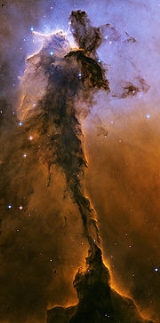
Eagle Nebula
Overview
Open cluster
An open cluster is a group of up to a few thousand stars that were formed from the same giant molecular cloud and have roughly the same age. More than 1,100 open clusters have been discovered within the Milky Way Galaxy, and many more are thought to exist...
of star
Star
A star is a massive, luminous sphere of plasma held together by gravity. At the end of its lifetime, a star can also contain a proportion of degenerate matter. The nearest star to Earth is the Sun, which is the source of most of the energy on Earth...
s in the constellation
Constellation
In modern astronomy, a constellation is an internationally defined area of the celestial sphere. These areas are grouped around asterisms, patterns formed by prominent stars within apparent proximity to one another on Earth's night sky....
Serpens
Serpens
Serpens is a constellation of the northern hemisphere. It was one of the 48 constellations listed by the 2nd century astronomer Ptolemy and it remains one of the 88 modern constellations defined by the International Astronomical Union....
, discovered by Jean-Philippe de Cheseaux
Jean-Philippe de Cheseaux
Jean-Philippe Loys de Chéseaux was an astronomer from Lausanne in Switzerland. In 1746 he presented a list of nebulae, eight of which were his own new discoveries, to the Académie Française des Sciences. The list was noted privately by Le Gentil in 1759, but only made public in 1892 by Guillaume...
in 1745-46. Its name derives from its shape which is resemblant of an eagle
Eagle
Eagles are members of the bird family Accipitridae, and belong to several genera which are not necessarily closely related to each other. Most of the more than 60 species occur in Eurasia and Africa. Outside this area, just two species can be found in the United States and Canada, nine more in...
. It is the subject of the famous "Pillars of Creation
Pillars of Creation
Pillars of Creation refers to a photograph taken by the Hubble Telescope of elephant trunks of interstellar gas and dust in the Eagle Nebula, some 7,000 light years from Earth. It was taken April 1, 1995 and was named one of the top ten photographs from the Hubble by Space.com...
" photograph by the Hubble Space Telescope
Hubble Space Telescope
The Hubble Space Telescope is a space telescope that was carried into orbit by a Space Shuttle in 1990 and remains in operation. A 2.4 meter aperture telescope in low Earth orbit, Hubble's four main instruments observe in the near ultraviolet, visible, and near infrared...
, which shows pillars of star-forming
Star formation
Star formation is the process by which dense parts of molecular clouds collapse into a ball of plasma to form a star. As a branch of astronomy star formation includes the study of the interstellar medium and giant molecular clouds as precursors to the star formation process and the study of young...
gas and dust
Interstellar medium
In astronomy, the interstellar medium is the matter that exists in the space between the star systems in a galaxy. This matter includes gas in ionic, atomic, and molecular form, dust, and cosmic rays. It fills interstellar space and blends smoothly into the surrounding intergalactic space...
within the nebula.
The Eagle Nebula is part of a diffuse emission nebula
Emission nebula
An emission nebula is a cloud of ionized gas emitting light of various colors. The most common source of ionization is high-energy photons emitted from a nearby hot star...
, or H II region
H II region
An H II region is a large, low-density cloud of partially ionized gas in which star formation has recently taken place. The short-lived, blue stars forged in these regions emit copious amounts of ultraviolet light, ionizing the surrounding gas...
, which is catalogued as IC 4703
IC 4703
IC 4703 is the diffuse emission nebula or HII region associated with Messier 16, which is actually a cluster of stars. It is the nebulous region surrounding Messier 16. These two objects make up the Eagle Nebula. They are relatively bright and are located in the constellation Serpens Cauda. This...
. This region of active current star formation is about 6,500 light-year
Light-year
A light-year, also light year or lightyear is a unit of length, equal to just under 10 trillion kilometres...
s distant.
Unanswered Questions
Discussions

